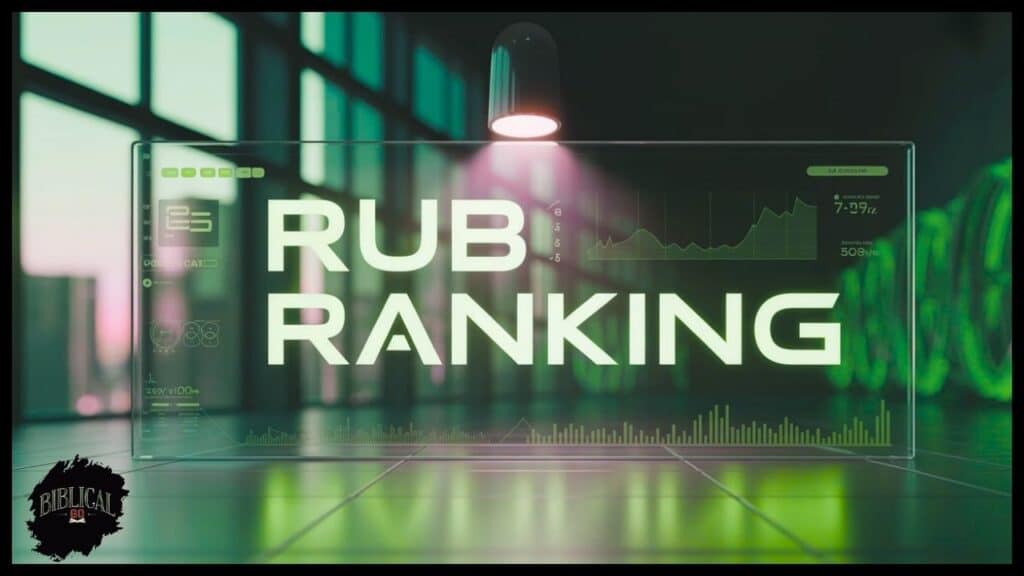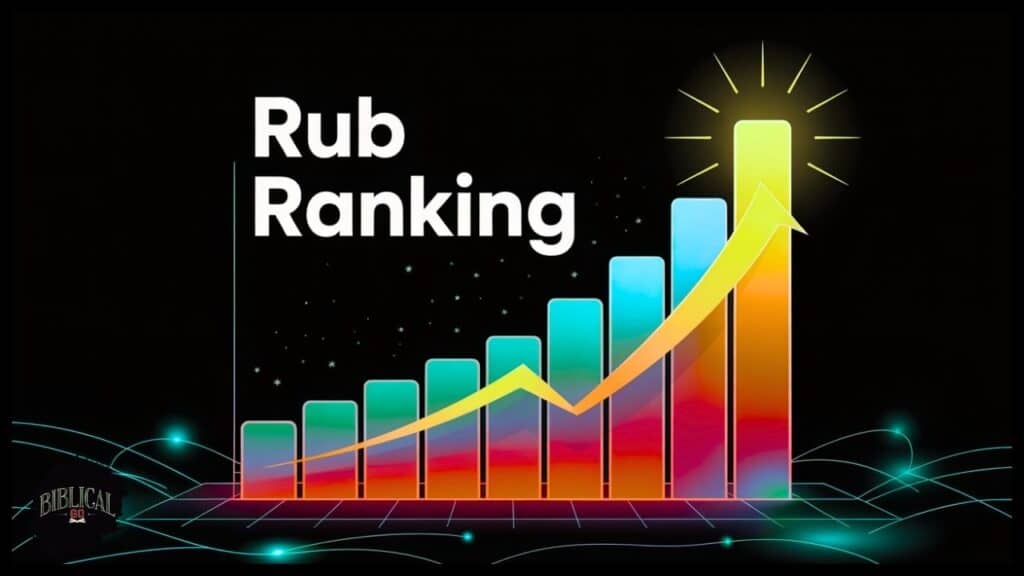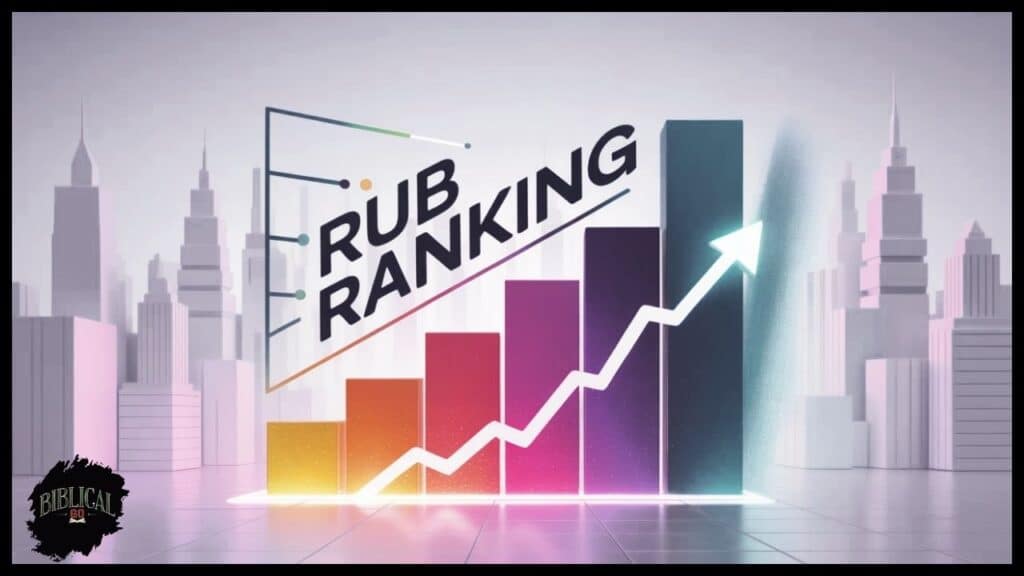Rub Ranking: Have you ever wondered why some reviews feel more trustworthy than others? Or why certain evaluation systems seem fairer and more transparent? The answer lies in a powerful methodology that’s quietly revolutionizing how we assess everything from student essays to job candidates: rub ranking.
Unlike traditional rating systems that rely on gut feelings or simplistic star ratings, rub ranking brings scientific rigor to the art of evaluation. It’s changing the game across industries, and you’re about to discover why.
What Exactly Is Rub Ranking?
Rub ranking represents a sophisticated approach to evaluation that combines the structured methodology of academic rubrics with modern ranking systems. Think of it as GPS for decision-making – instead of wandering around lost, you follow a clear, predetermined path to reach your destination.
At its core, rub ranking breaks down complex evaluations into specific, measurable criteria. Each criterion receives a weighted score based on its importance, creating a comprehensive evaluation framework that eliminates guesswork.
Here’s what makes it revolutionary:
- Transparency: Every score has a clear justification
- Consistency: Different evaluators reach similar conclusions
- Fairness: Bias reduction through structured processes
- Scalability: Works for 10 items or 10,000 items
Key Components of Every Rub Ranking System
| Component | Purpose | Example |
|---|---|---|
| Evaluation Criteria | Define what matters | Creativity, execution, clarity |
| Scoring Scale | Standardize measurements | 1-5 or 1-10 point scales |
| Weight Assignment | Prioritize importance | Creativity: 40%, Execution: 35%, Clarity: 25% |
| Evaluation Metrics | Track performance | Average scores, consistency rates |
The Fascinating Origins of Rub Ranking
The story begins in education, where teachers struggled with subjective vs objective evaluation. How do you grade an essay fairly? How do you ensure consistency across different instructors?
Academic roots emerged in the 1990s when educators developed analytic rubrics to solve these problems. Instead of assigning grades based on “gut feeling,” they created detailed scoring guidelines for each assignment component.
Evolution Timeline
- 1990s: Educational rubrics gain traction
- 2000s: Corporate adoption in HR departments
- 2010s: Digital transformation via online platforms
- 2020s: AI integration and automated scoring
The breakthrough came when businesses realized this methodology could revolutionize performance assessment and decision-making frameworks. Companies like Lattice and BambooHR began incorporating rubric-based systems into their platforms.
How Rub Ranking Actually Works
Understanding the mechanics reveals why rub ranking outperforms traditional methods. The process follows a systematic approach that transforms qualitative factors into quantitative factors without losing nuance.
The Four-Step Process
Step 1: Define Evaluation Criteria Every rub ranking system starts by identifying what matters most. For a restaurant review, you might use:
- Food quality (40% weight)
- Service (25% weight)
- Atmosphere (20% weight)
- Value (15% weight)
Step 2: Create Scoring Scales Each criterion needs a clear rating scale. A 5-point system might look like:
- 5: Exceptional
- 4: Above average
- 3: Meets expectations
- 2: Below average
- 1: Poor
Step 3: Apply Weighted Scores Raw scores get multiplied by their assigned weights. This score weighting ensures important factors have appropriate influence.
Step 4: Calculate Final Rankings The system aggregates weighted scores to produce final rankings with mathematical precision.
Real-World Application Example
Let’s say you’re evaluating freelance writers using rub ranking:
| Criterion | Weight | Writer A | Writer B | Writer C |
|---|---|---|---|---|
| Writing Quality | 35% | 4.5 | 3.8 | 4.2 |
| Timeliness | 25% | 4.0 | 4.5 | 3.5 |
| Communication | 20% | 3.8 | 4.2 | 4.0 |
| SEO Knowledge | 20% | 4.2 | 3.5 | 4.5 |
| Final Score | 100% | 4.15 | 4.0 | 4.05 |
Writer A wins despite not leading in every category – this is the power of structured scoring.
The Psychology Behind Our Ranking Obsession
Why do humans love rankings so much? The answer lies in cognitive simplification – our brains crave order in a chaotic world.
Research shows that people make faster, more confident decisions when presented with ranked options. Rub ranking leverages this psychological tendency while adding scientific rigor.
Psychological Benefits Include:
- Reduced decision fatigue through clear hierarchies
- Increased confidence in choices made
- Social validation through comparative rankings
- Cognitive load reduction by simplifying complex decisions
However, human bias remains a challenge. Evaluator bias can still influence results, which is why bias reduction techniques are crucial for system integrity.

Where Rub Ranking Shines: Real Applications
Education Revolution
Educational institutions have embraced rub ranking for student assessment tools. Platforms like Canvas, Blackboard, and Google Classroom integrate sophisticated rubric systems.
Benefits in education:
- Grading consistency across multiple instructors
- Transparent decision-making for students
- Structured feedback for improvement
- Assessment standards alignment
Business Intelligence Transformation
HR performance metrics have been revolutionized through rub ranking. Companies report 35% improvement in hiring accuracy when using criteria-based assessment.
Popular business applications:
- Candidate evaluation during recruitment
- Employee performance reviews
- Vendor selection processes
- Product comparison frameworks
Consumer Review Evolution
Platforms like TripAdvisor, Yelp, and Rotten Tomatoes employ variations of rub ranking to provide more reliable consumer feedback.
Competitive Advantages That Matter
Rub ranking offers several compelling advantages over traditional ranking systems:
Transparency and Explainability
Every score comes with clear justification. Users understand exactly why Item A ranks higher than Item B.
Bias Reduction
Structured scoring minimizes subjective evaluation inconsistencies. While human bias can’t be eliminated entirely, it can be significantly reduced.
Scalability
Whether evaluating 10 candidates or 10,000 products, the system maintains consistency.
Real-time Adaptability
Digital rubrics can be updated instantly as priorities change.
Honest Limitations and Challenges
No system is perfect, and rub ranking has legitimate drawbacks:
Manipulation Vulnerabilities
Sophisticated users can “game the system” by optimizing for specific evaluation criteria rather than overall quality.
Over-quantification Risk
Some qualitative factors lose meaning when forced into numerical scales. The nuance of human judgment sometimes gets lost.
Context Loss
Score normalization can strip away important contextual information that might influence decisions.
Implementation Complexity
Creating effective rubric-based ranking systems requires significant expertise and resources.

Building Your Custom Rub Ranking System
Ready to create your own system? Follow this proven framework:
Phase 1: Foundation Setup
Define your objectives clearly:
- What are you trying to evaluate?
- Who will use the rankings?
- What decisions will the rankings inform?
Identify stakeholders:
- Decision-makers
- Evaluators
- End users
- Subject matter experts
Phase 2: Criteria Development
Brainstorm evaluation factors:
- Conduct stakeholder workshops
- Research industry standards
- Analyze competitor approaches
- Review historical decision patterns
Example criteria categories:
- Performance metrics (objective)
- Quality indicators (mixed)
- Behavioral factors (subjective)
- Strategic alignment (contextual)
Phase 3: Weight Assignment
Determine relative importance:
- Use surveys to gather stakeholder input
- Analyze historical decision patterns
- Consider industry benchmarks
- Test different weighting scenarios
Phase 4: Testing and Validation
Pilot your system:
- Start small with known entities
- Compare results to expected outcomes
- Gather feedback from evaluators
- Refine criteria and weights
Technology Solutions and Platforms
Enterprise Solutions
| Platform | Strengths | Best For |
|---|---|---|
| Lattice | Comprehensive HR focus | Employee performance |
| BambooHR | User-friendly interface | Small to medium businesses |
| Workday | Enterprise scalability | Large organizations |
Education-Specific Tools
- Canvas: Integrated rubric builder
- Blackboard: Advanced analytics
- Google Classroom: Simple implementation
Custom Development Options
For unique requirements, custom solutions offer maximum flexibility. Popular development approaches include:
- Web-based applications
- Mobile-responsive platforms
- AI integration capabilities
- API connectivity for data exchange
Real-World Success Stories
University Admissions Revolution
Challenge: A major university struggled with inconsistent application reviews across different departments.
Solution: Implemented comprehensive rub ranking for all admissions decisions.
Results:
- 40% reduction in application processing time
- 25% improvement in admitted student satisfaction
- 90% consistency rating among reviewers
Enterprise Vendor Selection
Challenge: A Fortune 500 company needed to streamline vendor selection across multiple departments.
Solution: Deployed standardized evaluation framework using rub ranking principles.
Results:
- $2.3 million annual cost savings
- 60% faster vendor selection process
- 95% stakeholder satisfaction rate
Rub Ranking vs Traditional Methods
| Factor | Rub Ranking | Traditional Ranking |
|---|---|---|
| Transparency | High – clear criteria | Low – opaque process |
| Consistency | High – structured approach | Variable – depends on evaluator |
| Bias Reduction | Moderate – systematic approach | Low – subjective influence |
| Implementation Time | Medium – requires setup | Fast – immediate use |
| Scalability | High – systematic process | Low – manual intensive |
Performance Optimization Strategies
Data Quality Assurance
- Regular criteria validation
- Evaluator bias monitoring
- Score normalization checks
- Feedback loop implementation
User Experience Enhancement
- Intuitive interface design
- Mobile-responsive platforms
- Real-time feedback systems
- Transparency reporting
System Maintenance Best Practices
- Regular rubric updates
- Performance metrics tracking
- User training programs
- Continuous improvement cycles
Future Trends and Emerging Opportunities
AI Integration Revolution
Artificial intelligence is transforming rub ranking through:
- Automated scoring for objective criteria
- Bias detection algorithms
- Predictive ranking capabilities
- Natural language processing for qualitative assessment
Industry experts predict 35% annual growth in AI-powered evaluation systems through 2027.
Blockchain Verification
Emerging applications include:
- Immutable scoring records
- Transparent decision-making audit trails
- Decentralized evaluation networks
- Smart contract automation
IoT Data Integration
Connected devices will enable:
- Real-time performance monitoring
- Objective data collection
- Automated criteria updates
- Predictive insights generation
Common Implementation Pitfalls
Rookie Mistakes to Avoid
Over-complex criteria structure: Keep it simple – 5-7 criteria maximum for most applications.
Insufficient stakeholder buy-in: Involve users in the design process to ensure adoption.
Inadequate testing: Always pilot your system before full deployment.
Static thinking: Build in flexibility for future criteria adjustments.
Change Management Strategies
- Gradual rollout approach
- Comprehensive training programs
- Regular feedback collection
- Success story sharing
Your Next Steps: Implementation Roadmap
Ready to implement rub ranking in your organization? Here’s your action plan:
Week 1-2: Assessment and Planning
- Define evaluation objectives
- Identify key stakeholders
- Research existing solutions
- Set project timeline
Week 3-4: System Design
- Develop evaluation criteria
- Assign weight distribution
- Create scoring scales
- Design evaluation framework
Week 5-6: Pilot Testing
- Select test group
- Implement rubric-based system
- Collect initial feedback
- Refine criteria and weights
Week 7-8: Full Deployment
- Train all users
- Launch system-wide
- Monitor performance metrics
- Establish feedback loops

Key Takeaways
Rub ranking represents a fundamental shift toward transparent decision-making and fairness in evaluation. By combining structured scoring with modern technology, organizations can make better decisions faster while reducing bias and increasing consistency.
The methodology works because it aligns with how humans naturally process information while adding scientific rigor to subjective judgments. Whether you’re evaluating employees, products, or academic performance, rub ranking provides a framework for better outcomes.
Success depends on:
- Clear evaluation criteria definition
- Appropriate weight assignment
- Consistent scoring scale application
- Regular system optimization
- Stakeholder engagement throughout
The future belongs to organizations that can evaluate options quickly, fairly, and transparently. Rub ranking provides the framework to achieve all three simultaneously.
Frequently Asked Questions
Q: How long does it take to implement a rub ranking system?
A: Implementation typically takes 4-8 weeks depending on complexity and organizational size. Simple systems can be operational in 2-3 weeks.
Q: What’s the average cost of implementing rub ranking?
A: Costs range from $5,000 for basic systems to $50,000+ for enterprise solutions. Open-source alternatives can reduce initial investment significantly.
Q: Can rub ranking be used for creative fields?
A: Absolutely. Creative evaluation benefits from structured scoring by separating technical execution from artistic merit and originality.
Q: How do you handle disagreements between evaluators?
A: Inter-rater reliability protocols include calibration sessions, bias reduction training, and statistical analysis of scoring patterns.
Q: Is rub ranking suitable for small businesses?
A: Yes, small businesses often see the biggest impact due to improved decision-making consistency and reduced evaluation time.
Read more knowledgeable blogs on Biblical Go

Piper McMillan is a devoted writer and Bible enthusiast, offering insightful guides on Bible verses. Her blog provides practical interpretations and reflections, helping readers deepen their faith and understanding of Scripture through accessible and inspiring content.



